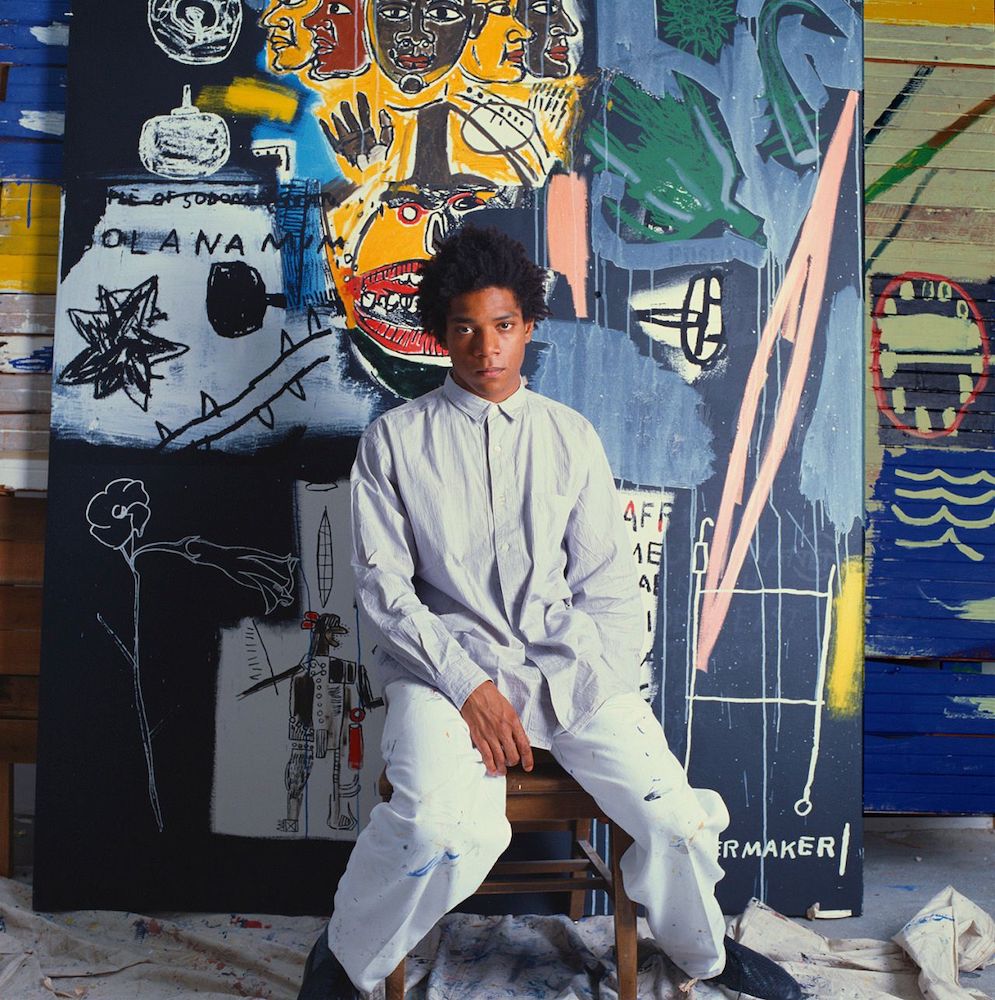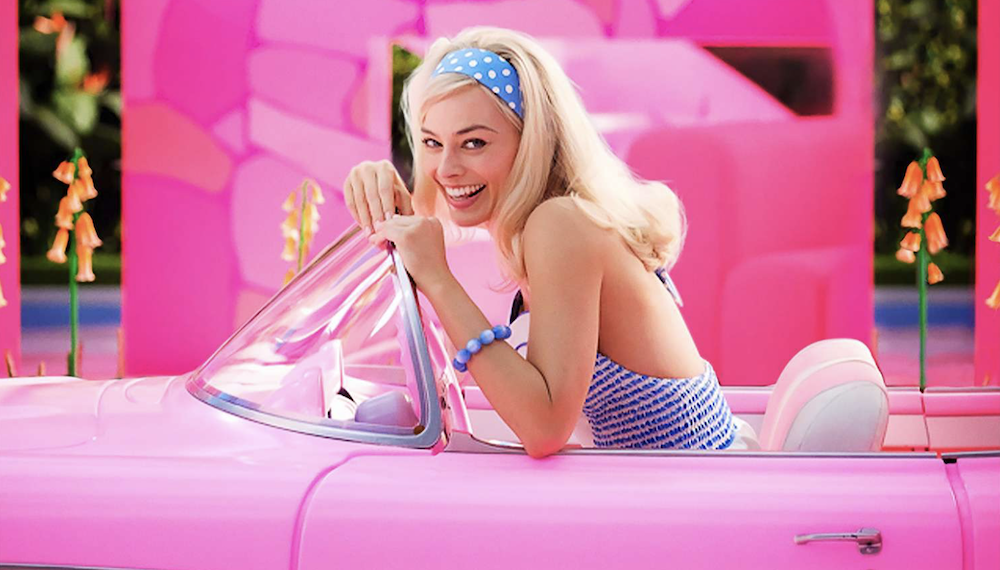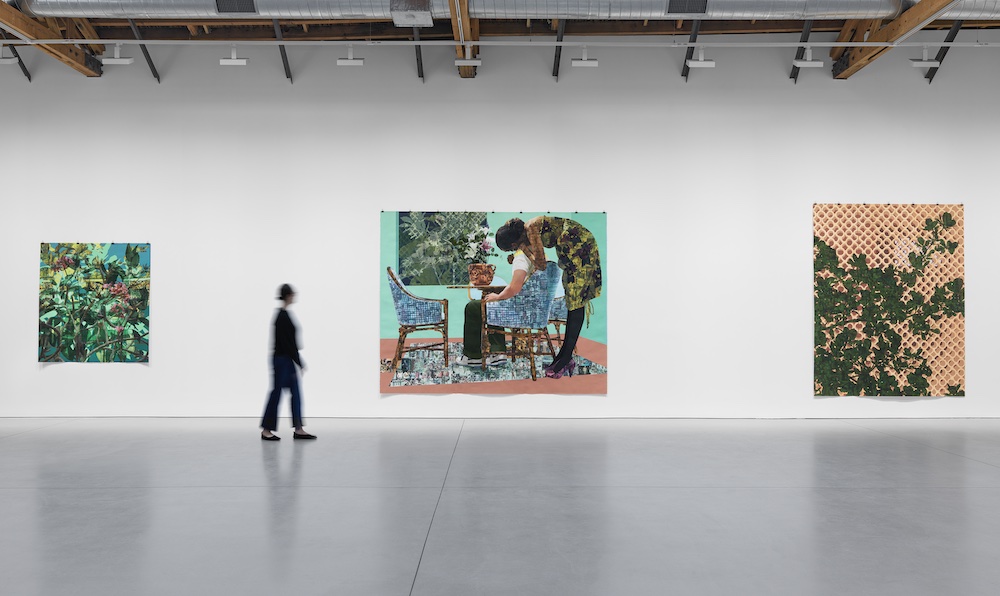Melrose Hill or Bust
We now have critical culture-mass in the area of Western Avenue between Melrose Avenue and Beverly Boulevard: half a dozen galleries have settled in, to be joined by LAXART any time now (the latter was supposed to have opened last year). This area has been dubbed “Melrose Hill” in some announcements, although Melrose Hill is actually elsewhere. That aside, the biggest boy on the block is David Zwirner from New York, with two adjoining buildings and a third under construction. The inaugural show in the north building was strategic and well-timed—“Coming Back to See Through, Again,” Njideka Akunyili Crosby in her first show with Zwirner. She’s one of LA’s most gifted artists, and her large works on paper are wonderfully layered—both narratively and literally—with patches of photo transfer juxtaposed with painting.
“I’m Nigerian, I’m American; you can be both,” she said in a recent New York Times interview: “I think places are richer for having difference.” In one painting, Still You Bloom in the Land of No Gardens, a mother staring directly out from the picture plane lovingly holds her young daughter in a backyard, while beautiful green fronds and vines swirl up and around them. Another, New Haven (Enugu) in New Haven (CT), is an interior still life, the left half taken up by a closet full of colorful clothing, while our eye is drawn to a small table on the right with its teapot, plant and a framed photograph of a young girl in a white dress. These are portraits of intimacy and tenderness, while the interlaced photo-collages reference a wider world; they are taken from her own archives and from Nigerian magazines.

Jean-Michel Basquiat in LA, photo by Brad Branson.
Grand Avenue’s Art Stars
Another hotbed of art is currently on Grand Avenue in DTLA—remember, you can now get there by the Metro and not worry about the exorbitantly priced parking. There’s the stunning Keith Haring show at the Broad, “Keith Haring: Art is For Everybody” (up through Oct. 8). There’s the very smart look at art in LA before the building of Museum of Contemporary Art (MoCA), “Mapping an Art World: Los Angeles in the 1970s–’80s” at MoCA Grand (up through March 10, 2024). Then there’s the “Jean-Michel Basquiat: King Pleasure” immersive (up through Oct. 15) in the building across from Disney Hall. For art aficionados the latter is quite worthwhile, as it includes around 200 drawings and paintings from Basquiat’s short but meteoric career. Some are displayed in replicated rooms including his studio, where his work covers the floor and walls. Another section recreates his childhood home, with the living room on one side and dining room on the other. It’s very ’60s middle-class Brooklyn. Basquiat was born into a well-off family, although he had to deal with his parents’ separation and his mother’s mental illness, and became a rebel, taking drugs and quitting school.
Much of the art is hung like a regular exhibition, according to chronology and themes in his art. These are accompanied by pithy, well-written text panels. This loving tribute to an artist who died far too young—it’s still shocking to think he died at 27—was curated by his two sisters, Lisane Basquiat and Jeanine Heriveaux. So naturally it feels personal—very different from what one usually sees at a museum.
These immersives are not cheap—admission prices for the Basquiat show range from $28 to $35. Museum prices have been creeping up too, but here in LA the trend has been toward free admission. That includes the Hammer, MoCA and The Broad (although the Keith Haring show requires a special ticket which costs $22 for adults). You can even get into LACMA for free on weekdays after 3 p.m. if you are an LA County resident—something I only found out this year.

Still from Barbie.
Barbie vs. Oppie
At the cinema it’s been the summer of Barbenheimer, so it would be amiss not to opine on the two movies that opened the same weekend and have throngs streaming back into theaters. In case you have been living under a rock or in deep isolation, Barbie, directed and co-written by Greta Gerwig, is based on the ultra-skinny, femmy doll that girls have been playing with since the late 1950s. Oppenheimer, directed and written by Christopher Nolan, is about physicist Robert Oppenheimer who assumed a god-like aura when he became “father of the atomic bomb” in 1945, but was subsequently brought down during the Red Scare of the next decade.
Let me just say, Barbie is the winner. Not only because it’s a blockbuster hit, bringing in over a billion dollars, Barbie is also one of the funniest and most inventive films you will see this year—and the most political—playing on our notions of the Barbiedom (whether you love it or hate it), hyper-consumption and patriarchy.
Margot Robbie plays a pitch-perfect stereotypical Barbie in Barbieland, a confectionary fantasy with lots of pink and lots of feel-good. Until one day during a pool party, with 100 of her closest friends, she begins to have thoughts of death and the Real World. To repair the rift in the fantasy-reality continuum, she travels to the Real World—with Ken (Ryan Gosling) as a stowaway—where men look at her lustfully, as an object, while Ken finds himself admired just for being a white guy. Insert a visit to Mattel headquarters, an LA high school and Santa Monica Beach, and Barbie gets an education she brings back to Barbieland. So does Ken, who finds patriarchy very appealing indeed.
I just went to see Barbie again out in the burbs, and it was packed on a Tuesday night, despite running at what looks like three
theaters in the multiplex. There were lots of girls and women, of course, but there were also lots of men, who also laughed heartily at the jokes about patriarchy. We’ve learned something about toxic masculinity this past decade, and Barbie so very cleverly plays on how ridiculous, even crippling, our traditional definitions of male and female behavior can make us.


